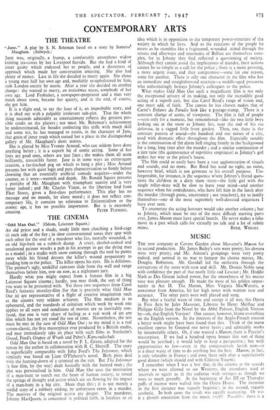THE CINEMA
'Odd Man Out." (Odeon, Leicester Square.)
AN old priest and a shady, seedy little man clutching a bird-cage sit each side of the fire ; in slow conversational tones they spar with each other for the soul of a murderer who lies, mortally wounded, in an old hip-bath on a rubbish dump. A crazy, alcohol-soaked and untalented painter wrecks a pub in his attempt to get the dying man as a model ; in a studio with snow coming through the roof he paints away while his friend dresses the killer's wound preparatory to handing him to the police. The killer opens his eyes. He is delirious. The painter's ugly, unskilful canvases slide from the wall and range themselves before him, row on row, as a nightmare jury.
Hardly what you might expect from a feature film in a big Leicester Square cinema ; hardly, you may think, the sort of thing you want to be presented with. Yet these two sequences from Carol Reed's fantastic morality-film (for that is precisely what Odd Man Out is) are representative of a flight of creative imagination such as the cinema very seldom achieves. The film medium is so ephemeral, and the standards of criticism which week by week one applies to all sorts and conditions of movies are so inevitably con- fused, that one is very chary of hailing as a real work of art any film which has not yet stood the test of time. Nevertheless, the test must be met in the case of Odd Man Out to my mind it is a real screen-classic, the first masterpiece ever produced by a British studio, and may immediately take its place with such films as Stroheim's Greed, Ford's Grapes of Wrath and Pabst's Kamtradschaft. Odd Man Out is based on a novel by F. L. Green, adapted for the screen by the author in collaboration with R. C. Sherriff. The story is superficially comparable with John Ford's The Informer, which similarly was based on Liam O'Flaherty's novel. Both plots deal with the hunting-down of a criminal on the run. But The Informer (a fine film, by the way) dealt basically with the hunted man ; the plot was personalised in him. Odd Man Out uses the motivation of a man-hunt to search out the heart of human society, to reveal the springs of thought and action which are set flowing by the impact of a man-hunt in a big city. More than this ; it is not merely a sordid story of a robbery ending, by unforeseen error, in a murder. The motives of the original action are deeper. The murderer, Johnny MacQueen, is concerned in political faith, in loyalties to an
idea which is in opposition to the temporary power-structure of the society in which he lives. And so the reactions of the people he meets as he stumbles like a frightened, wounded :nimal through the streets and alleyways and tenements of Belfast are themselves com- plex, for in Johnny they find reflected a questioning of society. Although they cannot avoid the implications of murder, their actions cannot be so simple as a call for the police ; there is a more pressing, a more urgent issue, and they compromise—some for one reason, some for another. There is only one character in the film who has an immediate and straightforward reaction—a middle-aged procuress who unhesitatingly betrays Johnny's colleagues to the police. What makes Odd Man Out such a magnificent film is not only the exceptional artistry of its making, not only the incredibly good acting of a superb cast, but also Carol Reed's range of vision and, one must add, of faith. The canvas he has chosen makes that of Carnes Enfants du Paradis look like a postage-stamp. There is a constant change of scene, of viewpoint. The film is full of people —seen only for a moment, but remembered—like the two little boys looking out at the snow as Johnny lies, near the end of his via dolorosa, in a ragged little front garden. Then, too, there is the constant pattern of sound—the hundred and one noises of a city, used with dramatic effect throughout the film. Especially notable is the continuation of the alarm bell ringing faintly in the bzckground for a long, long time after the murder ; and a similar continuation of a jazz tune (the quintessence of repetitive emptiness) as Johnny's girl makes her way to the priest's house.
The film could so easily have been a vast agglomeration of visuals and sounds, and no more. But Reed has used no sight, no noise, however brief, which is not germane to his overall purpose. Un- forgettable, for instance, is the sequence where Johnny's friend ques- tions the children in a dirty slum street—the little girl with the single roller-skate will be slow to leave your mind—and another sequence when his confederates, who have left him in the lurch after the murder (through panic, uncertainty ; not treachery), try to justify themselves—one of the most supremely well-directed sequences I have ever seen.
To enumerate the acting honours would take another column ; but as Johnny, which must be one of the most difficult starring parts ever, James Mason must have special laurels. He never makes a false move in a part which calls for virtually no talk and a lot of subtle


































 Previous page
Previous page